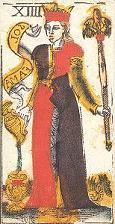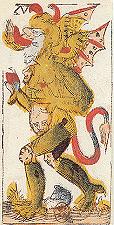most cards shown in this page come from the replica of J. Viéville's tarot
(marked JV) made by Héron (France)
THE TRUMPS
Despite the several differences pointed out so far, Viéville's tarot
is indeed similar to Marseille's pattern for most of its subjects; many details match,
and only a few trumps substantially differ, all of which belonging to the second half
of the series.
Among the quasi-identical ones is Justice, whose female figure lost one position
in ranking, but gained a pair of wings. These are a graphic corruption of the upright
rear part of a chair or throne seen behind this allegory in the classic illustration
from Marseille.
The twelfth trump, the Hanged Man, besides the reverse left-right orientation,
seems to have been rotated, as well.
In fact, the number at the base of the card is IIX,
i.e. a XII turned upside-down. Actually, this could also be the same XII
turned left to right, but since no other number among the cards of
the set appears reversed in this direction, and since this is the only subject
whose number is printed at the bottom of the card, we may reasonably think that
in the eyes of Jacques Viéville the Hanged Man was to be held in a
"head-up feet-down" position, despite in this way the already peculiar
attitude of the personage looks even more unnatural.
As mentioned in the Marseille gallery, part 2, problems
in orienting this subject were sometimes found in some Marseille tarot editions,
as well. The one shown on the far right has the number correctly placed,
i.e. above the illustration, but spelt upside down, despite the name at the
bottom makes it clear that this was the right way of looking at the card. |
the Hanged Man, by JV (left) and by
I.Krebs (18th century, Marseille pattern) |

JV - Temperance |
More differences are found in Temperance,
although at first sight they are not so eye-catching: the female figure is
crowned, but without the wings she had been given in southern France
(they were "stolen" by the aforesaid Justice). She no longer holds a vase in each
hand, but a vase and a sceptre; the other vessel is resting on the ground.
A completely new feature is the ribbon, or cartouche, on which runs vertically
the motto SOL FAMA, "the only fame", whose
meaning may be "the only virtue (to be remembered for)". What is more interesting,
though, is that the text is reversed, while the number XIIII is correctly spelt.
This may suggest that the engraver was not too aware of the writing's meaning,
and did not give the motto a great consideration, copying it merely as a graphic detail; this
would also be consistent with the hypothesis mentioned in part 3
of a pattern whose plate may have been obtained by copying another deck, i.e. a
positive model, whose text was spelt correctly, while the number XIIII
may have not been copied from the same older model, and correctly
added to the subject. |
Another unusual feature is the colour scheme used for the figure's dress:
half red and half blue, almost arranged as the quarters of a heraldic crest,
probably referring to temperance as the virtuous blend of two opposites (also
note how a blue fluid is being poured into a red one).
The Devil takes us back to the late medieval
tradition, as it features a demon with many faces all over its body. The
creature is seen sideways, without any small additional demon, unlike
the Marseille scheme.
A similar representation was used by Italian tarots, in particular those of
Bologna, which may suggest a further shade of influence for Viéville's tarot,
this time coming from Dummett's group A, or southern group.
The sixteenth trump is Lightning.
Apparently, the winds of change that in the south of France had turned this
subject into la Maison Dieu did not reach Paris, where the original
name survived.
|

JV - the Devil |

JV - Lightning |
Unlike the card from the
Tarot of Charles VI, more consistent with Marseille's pattern
( click here for a picture), Viéville's allegory features a man below a
tree, seeking shelter from a pouring rain that some clouds deliver after having covered
the sun. Some of the "drops" are red and yellow, and likely refer to thunderbolts, whereas
the clouds darkening the sun represent more symbolically God's rage.
This interpretation is probably more naive than the one used in earlier decks; the allegory
found in the late 16th century Tarot de Paris
basically had the same meaning, although its visual impact is even more symbolic,
as thunder is represented by a demon with a drum.
The Lightning trump survived in the Flemish tarot ( Regional
Tarots, part 4),
but definitively subsided when this pattern died out. |
the Star, featuring an astronomer
tarot de Paris (left) and JV |
|
The three cosmological subjects are rather close to the
Tarot of Charles VI, and prove once again a relation between
the tarots made in Paris and the ones from north-eastern Italy; today, the
closest traces of this early pattern are found in Bologna's tarot.
However, Viéville's set does not overlap the classic sequence of trumps
of Ferrara's tarot, as if their ranking had been partially rearranged, and among them
is even a new subject.
For an easy reference, the following
table summarizes the subjects and ranks found in the tarots compared so far.
|
|

the Star,
tarot of Ercole I d'Este,
second half of the 1400s
|
| | | Paris and Wallon |
|---|
| | | Ferrara |
|---|
| | | Bologna |
|---|
| | | central Italy |
|---|
|
THE STAR | THE MOON | THE SUN |
| tarot by J.Vieville (17th c.) | a sitting astronomer | a woman with a long spindle | a naked rider on horseback |
|---|
| Tarot de Paris (17th c.) | a sitting astronomer | a woman with a long spindle | a woman and a monkey |
|---|
| tarot of Ercole d'Este (15th c.) | two standing astronomers | a sitting astronomer | Diogenes in a barrel |
|---|
| tarot of Charles VI (15th c.) | (missing) | two standing astronomers | a woman with a long spindle |
|---|
| Bologna tarot | three dignitaries (Wise Men?) | two standing astronomers | a woman with a long spindle |
|---|
| Minchiate | a dignitary on horseback | a sitting astronomer | a young couple |
|---|
The table seems to suggest that the French cardmakers dropped one of the
two astronomy subjects, maybe because they considered them redundant, so that the
rank of the woman with a spindle was shifted back one position (from the Sun to
the Moon), whence the opportunity of introducing a new allegory for the third subject.
Alternatively, the French cardmakers may have dropped one astronomer card
for the specific purpose of bringing back the female figure to rank XVIII, so to respect
the ancient symbolic relation between the Moon and female nature. In fact, in
the Lombard tradition, i.e. in the Visconti tarots, as well as in Mantegna's cards,
the Moon features a female allegory,
representing goddess Diana, who often carries a bow and arrow. In the Cary sheet and
later on in Marseille's pattern, the allegory remained a female, who pours water into a river. |
|
the Moon from JV, the tarot of Charles VI and the tarot of Ercole d'Este |

trump 16, Leber tarot:
note the arrow's rear end |
The long spindle held by the woman in the Moon card of
French origin and in the Sun card of the tarot of Charles VI may in fact be a graphic
corruption of Diana's long arrow: in particular, the detail of its rear end.
This can be easily understood from a card belonging to the Leber tarot
(16th century, from northern Italy, but kept in Rouen, northern France), a non-standard
pattern whose trumps had Latin mottos instead of names. The subject no.16 features a rather
similar allegory, a female figure standing in the sea below an 8-pointed star, with
a long arrow pointing downwards; its rear part, i.e. where the feathers
are, is indeed very similar to the aforesaid spindle. |

the Sun, from the
tarot of Charles VI |
The nineteenth trump, the Sun, seems to be the one more freely interpreted, away from
the strict cliché of the two twins found in the Lombardy-Marseille scheme.
In Vieville's edition a blonde naked rider on horseback carries a two-colour flag,
without any specific clue except the red cross on the horse's hindquarters,
although this likely represents the animal's harness, rather than a crest.
This cross is very similar to the one that in most tarot editions (including Vieville's own)
appears in the following subject, Judgement, on the flag that hangs from the angel's
trumpet, and is a traditional symbol of resurrection.
Almost surprisingly, the last card, the World, abandons the north-eastern
Italian scheme and turns back again towards the southern French heritage, featuring the
classic female figure that holds a sceptre, inside the almond-shaped wreath,
with the Tetramorph (i.e. the evangelists' symbols) in the four corners.
|
|
JV - the Sun |